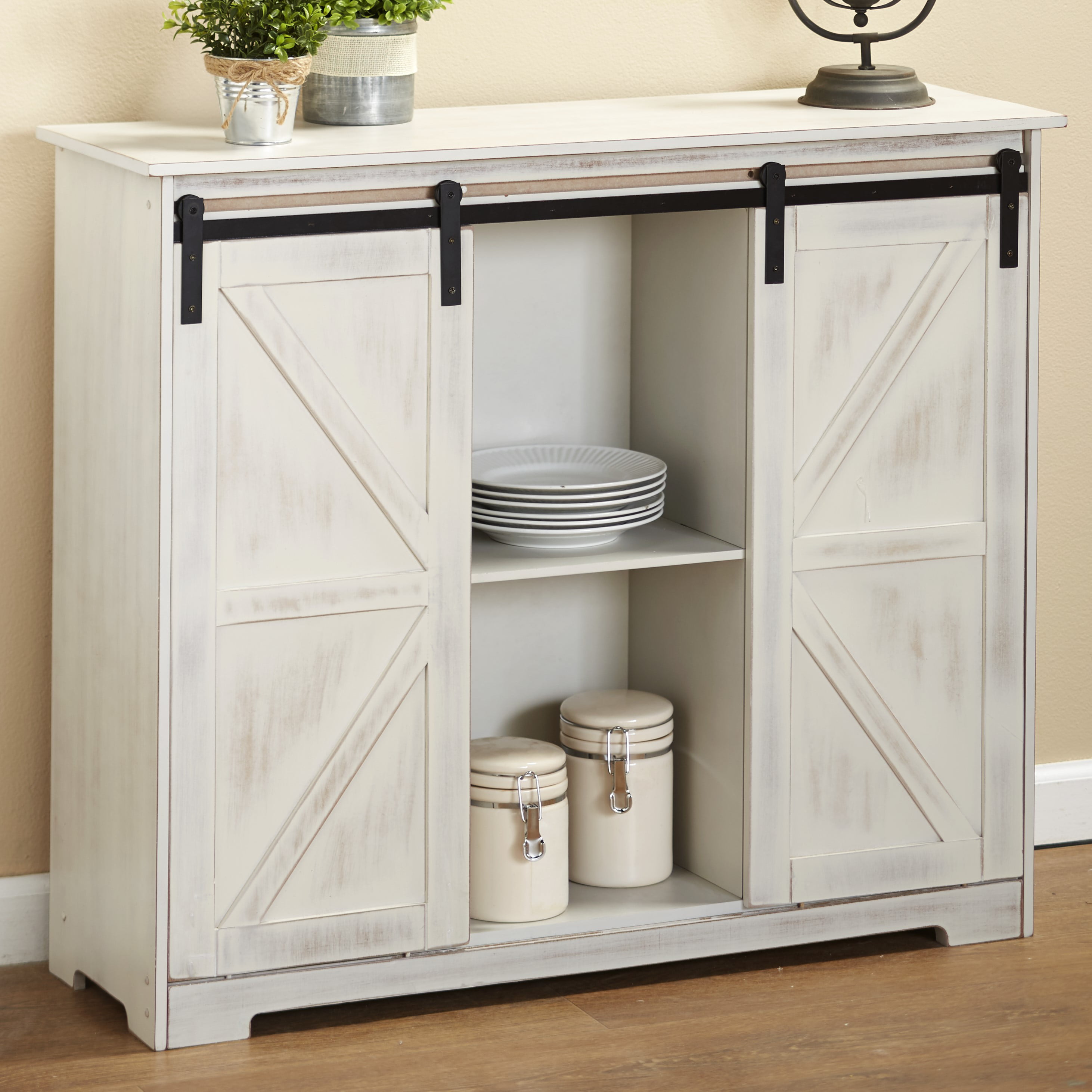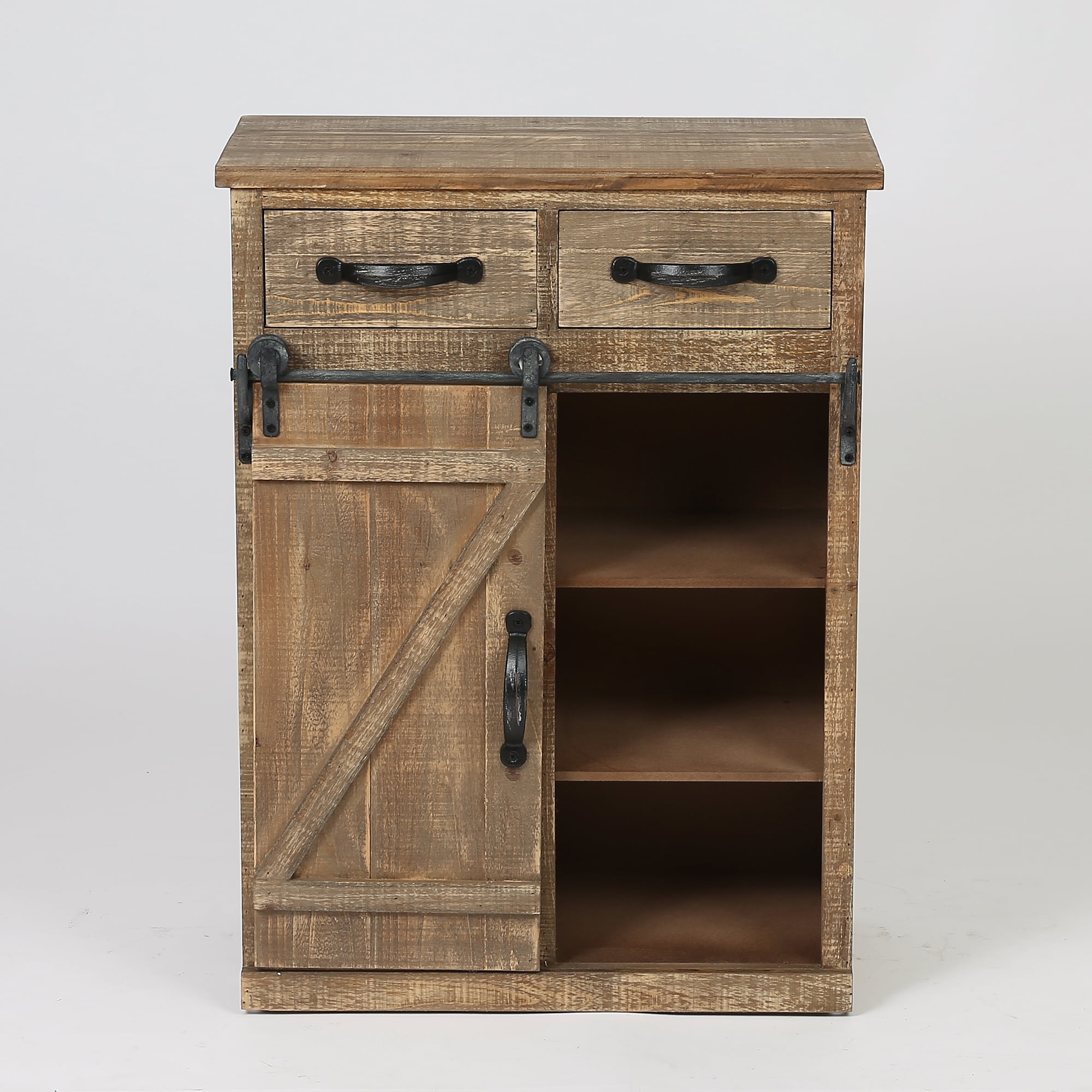Design and Functionality

Sliding farm door wood cabinets offer a unique blend of style and functionality, bringing a touch of rustic charm to modern interiors. These cabinets differ significantly from traditional cabinets, presenting both advantages and disadvantages that homeowners should consider.
Advantages and Disadvantages of Sliding Farm Door Wood Cabinets
Sliding farm door cabinets offer several advantages over traditional cabinets:
- Space-Saving: Sliding doors require no swing space, making them ideal for smaller kitchens or areas with limited floor space. They can be particularly useful in narrow spaces where traditional doors would hinder movement.
- Enhanced Aesthetics: The rustic charm of sliding farm doors adds a unique visual appeal to any room. They can create a focal point and enhance the overall design aesthetic, especially in farmhouse or rustic-themed interiors.
- Easy Access: Sliding doors provide wide, unobstructed access to the cabinet contents, eliminating the need to maneuver around swinging doors.
However, there are also some disadvantages to consider:
- Cost: Sliding farm door cabinets are generally more expensive than traditional cabinets due to the specialized hardware and construction required.
- Potential for Dust Accumulation: The sliding mechanism can sometimes trap dust and debris, requiring more frequent cleaning compared to traditional cabinets.
- Limited Storage Options: The design of sliding doors can limit the types of storage options available within the cabinet, such as shelves or drawers.
Types of Sliding Mechanisms
Sliding farm door cabinets utilize various mechanisms to ensure smooth and reliable operation:
- Roller Mechanisms: These mechanisms use rollers mounted on the bottom of the door to glide along a track. They are typically budget-friendly and offer smooth operation. However, they may be less durable than other options and can be susceptible to wear and tear over time.
- Track Mechanisms: These mechanisms involve a track mounted on the top and bottom of the door, allowing it to slide smoothly. Track mechanisms are generally more robust and durable than roller mechanisms. They are also less prone to dust accumulation.
- Pocket Mechanisms: Pocket mechanisms are designed to conceal the door within the wall when open. This creates a seamless look and maximizes space. However, they are more complex to install and require a dedicated pocket within the wall structure.
Wood Species for Farm Door Cabinets
The choice of wood species plays a crucial role in the durability, aesthetics, and cost of farm door cabinets:
- Oak: A classic choice for farm door cabinets, oak is known for its durability, strength, and distinctive grain pattern. It is a relatively expensive option but offers excellent longevity.
- Pine: Pine is a softer wood, making it easier to work with and less expensive than oak. It offers a warm, rustic aesthetic and is suitable for lighter-duty cabinets.
- Maple: Maple is a hard, durable wood with a beautiful, fine grain. It is a popular choice for cabinets due to its strength and resistance to scratches and dents.
- Cherry: Cherry is known for its rich, reddish-brown color and attractive grain pattern. It is a relatively expensive wood but offers a luxurious look and feel.
Design Example: Sliding Farm Door Cabinet
Here is an example of a sliding farm door cabinet design:
- Dimensions: 48″ wide x 36″ high x 18″ deep.
- Materials: Solid oak construction with a natural oil finish.
- Hardware: Track mechanism with soft-close feature, black metal hardware.
- Features: Integrated LED lighting on the top shelf, adjustable shelves.
Cost Comparison
The cost of sliding farm door cabinets varies significantly depending on factors such as materials, hardware, and labor:
| Option | Estimated Cost |
|---|---|
| Pine cabinet with roller mechanism | $500 – $800 |
| Oak cabinet with track mechanism | $1000 – $1500 |
| Custom-built maple cabinet with pocket mechanism | $2000 – $3000 |
Installation and Maintenance

Installing a sliding farm door wood cabinet is a straightforward process that can be completed with basic DIY skills and readily available tools. This section will provide a step-by-step guide for installing your cabinet, along with essential tips for maintenance to ensure its smooth operation and longevity.
Installation Guide
- Prepare the Wall: Begin by selecting a suitable wall for your cabinet. Ensure the wall is sturdy enough to support the weight of the cabinet and that there are no obstructions like electrical wires or plumbing pipes in the way.
- Mark and Drill Holes: Carefully mark the location for the cabinet on the wall, using a level to ensure it is straight. Then, drill pilot holes for the mounting screws, ensuring the holes are deep enough for the screws to secure the cabinet firmly.
- Install the Track: Attach the sliding track to the wall, using the pre-drilled holes and screws. Ensure the track is level and securely fastened to the wall.
- Mount the Cabinet: Carefully lift the cabinet and slide it onto the track. Ensure the cabinet is aligned correctly and sits securely on the track.
- Secure the Cabinet: Once the cabinet is in place, use the provided screws to secure it to the wall.
- Adjust the Sliding Mechanism: After installing the cabinet, adjust the sliding mechanism to ensure smooth operation. This may involve tightening or loosening screws on the track or the cabinet itself.
Maintenance
Regular maintenance is crucial for keeping your sliding farm door wood cabinet in top condition. Here’s a guide to common maintenance tasks:
- Cleaning: Dust and dirt can accumulate on the cabinet and track, hindering smooth operation. Regularly clean the cabinet and track using a soft cloth and mild cleaning solution. Avoid using harsh chemicals that could damage the finish.
- Lubrication: Apply a light coat of lubricant to the sliding mechanism to prevent friction and ensure smooth operation. This is especially important for areas that experience high wear and tear, such as the track and rollers.
- Hardware Replacement: Over time, cabinet hardware like hinges, handles, and rollers may wear out. Replace any worn-out or damaged hardware promptly to ensure the cabinet functions correctly and remains aesthetically pleasing.
Troubleshooting
Here are some common problems that might occur with sliding farm door wood cabinets and their solutions:
- Sticking or Squeaking: If the cabinet sticks or squeaks, it might be due to dirt, dust, or lack of lubrication. Clean the track and rollers, and apply lubricant to the sliding mechanism.
- Uneven Sliding: If the cabinet slides unevenly, check the track for any obstructions or misalignment. Ensure the track is securely fastened to the wall and that the cabinet is properly aligned.
- Loose Cabinet: If the cabinet feels loose, check the mounting screws and tighten them if necessary. Ensure the cabinet is securely attached to the wall and the track.
Styling and Customization: Sliding Farm Door Wood Cabinet

The beauty of sliding farm door wood cabinets lies in their versatility. You can seamlessly integrate them into various design styles, adding a touch of character and functionality to your space. Let’s explore how to customize these cabinets to complement your unique aesthetic and enhance your home’s ambiance.
Design Styles
Different design styles offer a range of visual expressions for sliding farm door wood cabinets. From rustic charm to modern minimalism, there’s a style to match every taste.
- Rustic: Embrace the warmth and authenticity of natural wood with a rustic style. Opt for reclaimed wood with knots and imperfections, and consider distressed finishes for a timeworn look. Rustic hardware like iron pulls or leather straps adds to the charm.
- Modern: Clean lines and sleek silhouettes define modern style. Choose smooth, lacquered wood surfaces in neutral colors like white, gray, or black. Minimalist hardware, such as brushed nickel or chrome pulls, complements the contemporary aesthetic.
- Farmhouse: Farmhouse style exudes warmth and comfort. Opt for distressed white paint or natural wood stains with a weathered finish. Hardware choices like antique brass or iron accents with a rustic touch enhance the farmhouse feel.
- Contemporary: Contemporary style blends modern and traditional elements. Use wood with a smooth, polished finish in rich colors like walnut or cherry. Sleek, modern hardware in brushed nickel or stainless steel complements the contemporary design.
Finishes and Hardware
The choice of finishes and hardware plays a crucial role in shaping the overall aesthetic of sliding farm door wood cabinets.
- Finishes: Consider wood stains in various shades to highlight the natural grain, or opt for painted finishes in colors that complement your room’s decor. Distressed finishes, glazes, or even metallic paints add depth and visual interest.
- Hardware: Hardware options are vast, from simple knobs and pulls to intricate designs. Consider the style of your cabinets and choose hardware that complements the overall design. For a rustic look, opt for iron or brass hardware with a distressed finish. For a modern aesthetic, choose sleek, minimalist hardware in brushed nickel or chrome.
Customization Options
Beyond basic design elements, you can personalize sliding farm door wood cabinets with unique features that enhance their functionality and visual appeal.
- Glass Panels: Integrate glass panels into the doors for a touch of elegance and to showcase items within the cabinet. Frosted glass offers privacy while allowing light to pass through, while clear glass provides a clear view of the contents.
- Decorative Accents: Incorporate decorative accents like molding, trim, or carved details to add visual interest. These accents can be customized to match your design style and enhance the cabinet’s overall aesthetic.
- Integrated Storage Solutions: Optimize storage within the cabinet with features like adjustable shelves, pull-out drawers, or built-in organizers. These solutions enhance functionality and create a more organized space.
Designing for a Specific Room Theme
Imagine a cozy living room with a rustic farmhouse theme. A sliding farm door wood cabinet painted in a warm white with distressed details would complement the space. The doors could feature a decorative accent of a simple, carved floral motif, adding a touch of elegance. Iron hardware with a rustic finish would complete the look.
A sliding farm door wood cabinet is a great way to add rustic charm to your space, and it’s perfect for maximizing storage in a small area. If you’re looking for inspiration on how to make the most of a small attic bedroom, check out this guide on decorating a small attic bedroom.
With its space-saving design, a sliding farm door wood cabinet can be a perfect fit for an attic bedroom, adding both style and functionality.
Sliding farm door wood cabinets are a stylish and practical addition to any kitchen or living room. But just like any other wood furniture, they need regular cleaning to keep them looking their best. You can use a commercial cleaner, but why not try making your own?
Check out this easy homemade wood cabinet cleaner recipe, which uses natural ingredients and will leave your sliding farm door cabinets sparkling clean.
